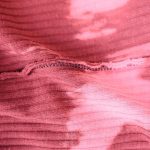So, you've mastered the art of knitting or crocheting, but now you want to take your skills to the next level by adding your own custom colors to your wool.
In this step-by-step guide, you'll learn how to dye wool with Rit like a pro. From preparing the materials to the final touches, we'll walk you through the process with clear and engaging instructions.
You'll need to gather a few materials and follow a specific dyeing process, but don't worry – it's easier than you think. By the end of this guide, you'll have the mastery you desire in dyeing wool with Rit, and you'll be ready to create beautifully dyed yarn for your next project.
Key Takeaways
- Preparing the wool properly is crucial for successful dyeing, including cleaning the wool and pre-soaking it in a water and vinegar solution.
- It is important to mix the Rit dye correctly by following the package instructions and testing it on a small piece of fabric or yarn before dyeing the entire batch.
- Maintaining a consistent temperature and gently agitating the wool in the dye bath every few minutes helps achieve even color distribution and optimal dye application.
- Thoroughly rinsing the wool with cool water, removing excess dye, and properly drying it on a drying rack or clean towel are essential steps in the dyeing process.
Materials Needed
You will need the following materials to dye wool with Rit:
- Vinegar
- Rit dye
- A large pot
- Stirring utensil
- Wool fabric
When it comes to wool dyeing techniques, using Rit dye offers a wide range of color selection to achieve the precise shade you desire. The vinegar acts as a mordant, helping the wool to absorb the dye evenly and efficiently.
In addition to Rit dye, there are alternative dyeing methods using natural dyes such as turmeric, onion skins, or black walnuts. These natural dyes can produce a beautiful range of colors, offering a more sustainable and environmentally friendly option for dyeing wool. However, when using Rit dye, the process is more predictable and offers a broader spectrum of colors.
The large pot is essential for dyeing wool, as it allows the fabric to move freely and ensures an even distribution of dye. A stirring utensil will help you agitate the wool and dye mixture, ensuring that the color is evenly distributed.
With these materials at hand, you're ready to begin the exciting process of dyeing wool with Rit.
Preparing the Wool
Before you begin the dyeing process, it's important to properly prepare the wool. This involves pre-treatment steps such as washing and mordanting to ensure the dye adheres evenly.
You'll also need to gather the necessary equipment for the preparation, including a large pot, stirring utensils, and a thermometer.
Wool Pre-Treatment Steps
To prepare the wool for dyeing, there are several important steps to follow.
First, thoroughly clean the wool using a gentle detergent. This will remove any dirt, oils, or residues that could hinder the dye absorption process. It is crucial to ensure that the wool is free from any substances that could interfere with the dyeing process.
Once the wool is clean, it is important to pre-soak it in a water and vinegar solution. This solution helps to enhance wool absorption and allows the dye to adhere more effectively. The wool should be submerged in this solution for at least an hour, allowing the fibers to fully absorb the mixture.
Pre-treating the wool in this manner is essential for optimizing the dyeing process. It ensures that the color is distributed evenly and helps to achieve vibrant and long-lasting results. These pre-treatment steps are crucial for achieving successful dyeing outcomes using various dyeing techniques.
Necessary Equipment for Preparation
After pre-treating the wool as described in the previous section, you'll need specific equipment to prepare the wool for dyeing. The following items are essential for this process:
- Equipment Selection:
- Stainless steel pot: Use a pot designated solely for dyeing purposes to avoid contamination.
- Stirring utensils: Wooden or stainless steel spoons work well and won't react with the dye.
Remember to take safety precautions during this process. It's crucial to work in a well-ventilated area and wear gloves to protect your skin from the dye. Additionally, consider the environmental impact and disposal considerations. Dispose of any leftover dye and chemicals responsibly to minimize harm to the environment.
Mixing the Rit Dye
You can mix the Rit dye by following the instructions on the package for the desired color intensity. Start by selecting the color of Rit dye that best matches your desired outcome. Once you have chosen your color, you can begin mixing the dye.
For pastel shades, use less dye, and for deeper, more intense colors, use more dye. To achieve the desired color depth, mix the dye with hot water according to the instructions provided. Stir the mixture until the dye is fully dissolved. Keep in mind that the color of the dye mixture will appear darker than the final result.
If you're unsure about the color intensity, you can always test the dye on a small piece of fabric or yarn before dyeing the entire batch. This will help you adjust the color intensity to your liking before dyeing your wool.
Mixing the Rit dye properly is crucial for achieving the perfect shade, so follow the instructions carefully and trust the process.
Dyeing Process
Begin by submerging the wool in the dye mixture, ensuring that it's fully saturated for an even color result. Once the wool is submerged, follow these steps to ensure a successful dyeing process:
- Control the Temperature:
- Maintain a consistent temperature of around 140°F to 160°F for optimal dye application and color fastness. Fluctuations in temperature can affect the dye absorption and result in uneven coloring.
- Agitate the Wool:
- Gently agitate the wool in the dye bath every few minutes to promote even color distribution. Be careful not to handle the wool roughly, as this can cause felting or uneven dye penetration.
Maintaining the wool in the dye bath for an adequate amount of time is essential for achieving the desired color depth. After the dyeing process, rinse the wool thoroughly with cool water until the water runs clear. Proper dye application and thorough rinsing are crucial for ensuring color fastness. Following these steps will help you achieve consistent and vibrant results, elevating your mastery in dyeing wool with Rit.
Rinsing and Drying
Once the wool has been thoroughly dyed, how do you ensure the dye is set and the wool is ready for use? The next crucial steps after dyeing are rinsing and drying.
Proper rinsing is essential to remove any excess dye that hasn't bonded with the wool fibers. Fill a sink or basin with cool water and gently submerge the wool, pressing out any remaining dye. Continue rinsing until the water runs clear, indicating that the excess dye has been removed. Thorough rinsing is vital to prevent color bleeding and ensure the wool's color remains vibrant.
After rinsing, it's time to dry the wool. To maintain the integrity of the dye and prevent any potential felting, it's important to use proper drying techniques. Gently squeeze out excess water without wringing or twisting the wool. Lay the wool flat on a clean towel and roll it up to absorb more moisture. Then, reshape the wool and lay it flat on a drying rack or another clean towel to air dry. Avoid direct sunlight or heat, as this can cause fading or damage to the wool fibers.
Final Touches
Now that your wool has been rinsed and dried, it's time to focus on the final touches.
You'll learn about color fixing methods and how to use fabric softener to ensure your newly dyed wool stays vibrant and soft.
These last steps will help you achieve professional-looking results and ensure your dyed wool lasts for a long time.
Color Fixing Methods
To fix the color of your wool dyed with Rit, you can use a color fixative to ensure the colors remain vibrant and don't bleed. Once your wool has been dyed, follow these final steps to lock in the color:
- pH Level Adjustment and Heat Setting
- Adjust the pH level of the dyed wool by soaking it in a vinegar or citric acid solution to help set the color.
- Heat set the wool by placing it in a dryer or using an iron, following the specific Rit dye instructions for the best results.
Using Fabric Softener
How do you incorporate fabric softener into the final steps of dyeing your wool with Rit? Fabric softener can be used as a final touch to the dyeing process to add softness and reduce any stiffness that may result from the dye. After rinsing the dyed wool until the water runs clear, prepare a solution of water and fabric softener according to the product's instructions. Submerge the wool in the fabric softener solution and let it soak for about 20-30 minutes. Then, rinse the wool thoroughly with water to remove the fabric softener. This final step will leave your wool feeling soft and luxurious.
Fabric Softener Benefits
| Benefits | Description |
|---|---|
| Softens Wool | Reduces stiffness and adds a soft, luxurious feel to the dyed wool. |
| Reduces Static | Helps to minimize static electricity in the dyed wool, making it easier to handle and wear. |
| Pleasant Fragrance | Leaves a pleasant scent on the wool, enhancing the overall sensory experience. |
Alternative Dyeing Methods
In addition to using fabric softener, there are alternative methods for softening dyed wool, such as using a vinegar solution or a lanolin-based wool wash. Each method offers its own unique benefits and can be chosen based on personal preference and the desired outcome.
Frequently Asked Questions
Can Rit Dye Be Used on Wool That Has Already Been Dyed or Treated With Other Chemicals?
Yes, Rit dye can be used on wool previously treated with other chemicals. However, test for colorfastness first. Wool blends are suitable, and custom color mixing is possible. Ensure skin safety when handling dyes.
How Long Will the Color Last on the Dyed Wool, and Will It Fade Over Time?
After dyeing wool with Rit, color fastness depends on the method and dye type used. Following the proper dyeing steps and using the right Rit dye for wool ensures longer-lasting, vibrant colors. Fading concerns can be minimized with proper care.
Can Rit Dye Be Used on Wool Blends, or Is It Only Suitable for 100% Wool?
Yes, Rit dye can be used on wool blends as well as 100% wool. The dyeing process for blends is similar, but colorfastness may vary. Always mix dyes carefully for custom colors and follow safety guidelines.
Is It Safe to Use Rit Dye for Dyeing Wool That Will Be Used for Clothing or Items That Come Into Contact With Skin?
Yes, it's safe to use Rit dye for dyeing wool that will be in contact with skin. Follow safety guidelines, ensure color fastness, and check dye compatibility. The dyeing process allows for custom color creation.
Can Multiple Colors of Rit Dye Be Mixed Together to Create a Custom Color for Dyeing Wool?
Yes, you can mix multiple colors of Rit dye to create custom shades when dyeing wool. It's important to ensure colorfastness and skin safety, so test the custom color on a small piece of wool before dyeing the entire item.
- The Use of Nonwovens in Construction and Civil Engineering - July 11, 2025
- The Use of Nonwovens in Construction and Civil Engineering - July 11, 2025
- The Use of Nonwovens in Construction and Civil Engineering - July 11, 2025







